Famous Trees
By Austin Explorer
What can be so famous about a tree? Plenty, of one considers the origin of the tree or events that are said to have taken place near it. Austin and the surrounding area has several such arboreal sites of interest.
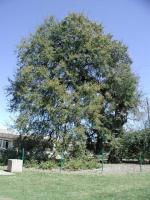
Treaty Oak
Treaty Oak is by far the most famous tree in Austin. This 500 year old giant was once one of fourteen trees referred to by local Indians as the Council Oaks. Treaty Oak in particular was revered by both the Commanches and Tonkawas. Legend states that it was under this tree that Stephen F. Austin signed a treaty with the Indians from which its name was derived. This majestic tree once sported a 127 foot spread and was considered to be the finest example of a mature oak in the world. In 1929 the tree was added to the American Forestry Association's compilation of famous and historic U.S. trees.

Treay Oak
Over the years the Council Oaks were cut down one by one until only Treaty Oak remained. The city of Austin purchased the tiny lot on which Treaty Oak stands in 1937, saving it from planned destruction. The tree that exists today is a shadow of its former self, thanks to a deranged person who tried to poison the tree in 1989. An extensive effort to save Treaty Oak was a success, but at a cost of sacrificing almost two thirds of its canopy. The tree continues to recover however and in 1997 produced its first acorns since the poisoning. Here you can see some of the signs of those rescue efforts.
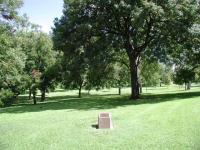
Washington Elm
At a spot on the Texas Capital grounds a Cedar Elm was planted to commemorate the bicentennial of George Washington's birth. The tree was descended from the Elm under which Washington assumed command of the Continental Army.
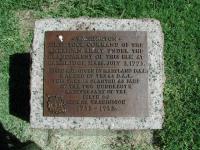
Washington Elm Plaque
For reasons unknown, Washington's Elm no longer resides on the Capital grounds though it's plaque remains to this day.
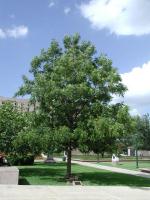
Memorial Pecan
Another famous tree on the Capital grounds is the Memorial Pecan, located to the west of the north entrance to the capital. This tree was first planted on May 30, 1945 to honor Texans who gave their lives in World War II, which was nearing an end at the time. The tree was planted in soil gathered from all 254 counties in Texas. The tree there today was planted on September 24, 1993 to replace the original.
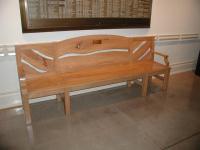
Memorial Pecan Bench
What happened to the original Memorial Pecan? It may have gotten in the way of the Capital's expansion and was removed. The wood from that pecan was used to create this bench, which now resides on the first level of the Capital extension complex. The plaque on the back of the bench positively identifies the wood's source.

Hogg Pecan
The Pecan is the official tree of Texas. How did it get that way? It can be traced to Governor James Hogg, who had requested that a Pecan and Walnut be planted at his grave instead of a headstone. He hoped that the nuts from the trees would be distributed around the state to be planted to make Texas a land of trees. Within a day of making the request he passed away in 1909 and was buried in Oakwood Cemetery south of MLK and east of UT.
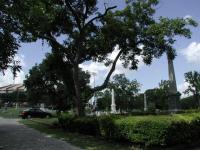
Hogg Pecan
The governor got his pecan and walnut, though both perished and were replaced in 1969. Since then the walnut has again died. When the Texas legislature designated the pecan as the state tree in 1919 credit for the decision was partly attributed to Governor Hogg's request. So when you look at this tree you are looking at the living source of the move to make the pecan the state tree.
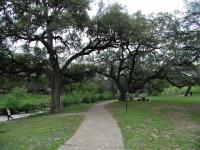
Seiders Oaks
This live oak grove was the the spot at which settler Gideon White, who had a cabin nearby, was killed by Indians in 1842, when Texas was still an independent nation. Gideon's daughter Louisa Maria married Edward Seiders and the two settled in the area's springs, which became known as Seiders Springs. In 1865 troops under the command of General George Custer camped under the oaks during their stationing in Austin. By the 1870's the springs had become a tourist attraction and Seiders built bath houses and a dance pavilion to entertain the guests, who were transported to and from the springs from the center of town. Today the oaks are a fixture along the
Shoal Creek greenbelt.
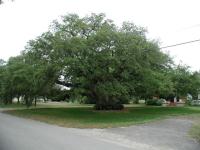
Kyle Auction Oak
In the 1870's the International and Great Northern Railroad planned to build a line between San Antonio and Austin. A station was needed between San Marcos and Austin, but no town existed. So the company created one from lands provided by D.R. Moore and Captain Ferguson Kyle, for whom the town is named. It was under this tree that the newly surveyed business and residential lots were auctioned off.
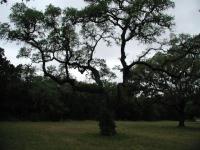
Kyle Hanging Tree
In the 1840's cowboys searching for stray cattle came upon a man hanging from a tree. The identity of the man, who hung him and for what reason has never been determined. The man was buried on the spot and eventually a Kyle family friend was also buried there. Colonel Kyle (Captain Kyle's father) donated 15 acres of land to serve as a community cemetery. So Kyle's first cemetery was chosen by an unknown assailant, hanging and unknown man for unknown reasons.
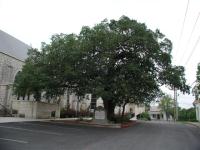
Church Oak
Folklore holds that this tree marks the site of an Indian village that played host to an early missionary at the dawn of Texas history. A chief's daughter reportedly had a vision that resulted in the first German in Texas to be freed. The tree sits next to the Saints Peter and Paul Catholic Church on Castell Street in New Braunfels.
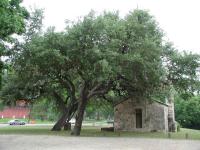
Kissing Oak
Senator Sam Houston made a campaign address beneath this tree during his unsuccessful gubernatorial effort in 1857. In honor of his visit, several young ladies created a Texas flag to present to the former President of the Republic of Texas. While thanking the crowd after his speech, Houston kissed each of the women to show his appreciation and provided the inspiration for the tree's name.
